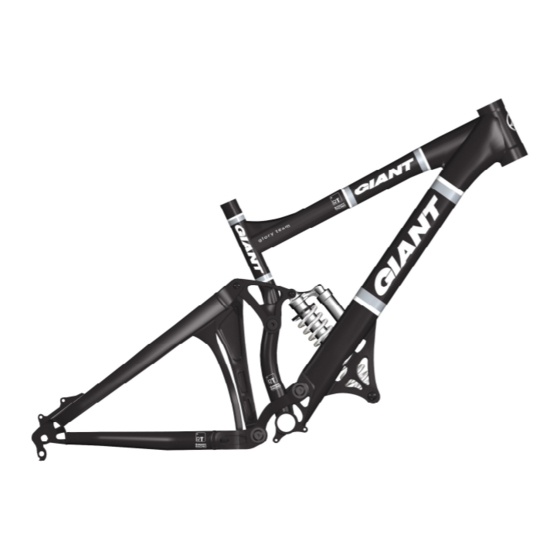
Giant GLORY - SERVICE MANUAL V2.0 Service Manual
Hide thumbs
Also See for GLORY - SERVICE MANUAL V2.0:
- Specifications (1 page) ,
- Manual (1 page) ,
- Technical manual (1 page)
Table of Contents
Advertisement
•
Maestro suspension performance. No brake influence, no pedal kickback, linear rising rate,
superb traction, and efficient pedaling.
•
A mile stiffer frame, especially the rear triangle, which makes high speed cornering rock
stable and full power sprinting rocket fast.
•
Best traction and steering thanks to the linear rising rate.
•
8.8-inch travel luxurious suspension.
•
Oversized headset parts for greater strength & stiffness.
- 1 -
Version 2.0
Advertisement
Table of Contents

Summary of Contents for Giant GLORY - SERVICE MANUAL V2.0
- Page 1 Version 2.0 • Maestro suspension performance. No brake influence, no pedal kickback, linear rising rate, superb traction, and efficient pedaling. • A mile stiffer frame, especially the rear triangle, which makes high speed cornering rock stable and full power sprinting rocket fast. •...
-
Page 2: Table Of Contents
ABLE ONTENTS Notice to authorized Giant dealers Spare Parts • Exploded Diagram • Spare Parts List Torque Specifications Frame Technical Data Set-up of Rear shock and Front Suspension • Coil Shock Set-up • Setting and Adjusting Rebound Damping • Front Suspension Travel & Sag Guide Maintenance •... -
Page 3: Notice To Authorized Giant Dealers
Notice to authorized Giant dealers The Glory is a new Downhill bike equipped with the Maestro suspension system. It inherits all the excellences of Maestro suspension technology and is tuned and polished to be the most efficient downhill dominator. The Glory is enhanced in a generous way with better traction, steering, rigidity and acceleration, at the same time, no braking influence, pedaling kickback and bobbing, giving a great hand pushing the rider onto the podium. -
Page 4: Spare Parts
Spare parts • Figure 1- Exploded Diagram Seq# Articl# Name Description RE8D REPLACE END SET 0060 12806GU0072A1 DROPOUT (FOR STANDARD) RE8DA REPLACE END SET 0070 12806GU0073A7 DROPOUT (FOR SHIMANO) RE8DB REPLACE END SET 0080 12806GU0074A4 DROPOUT (FOR ROCKSHOX) GS0243 TOP ARM+BOLT(JP61 SIL) 0460 12806GU0066A2 T.LINK+BOLT... -
Page 5: Torque Specifications
Torque Specifications 11.8-14.7 Nm (104-130 in. lbs.) 11.8-14.7 Nm (104-130 in. lbs.) - 5 -... -
Page 6: Frame Technical Data
Frame Technical Data Rear wheel travel 8.8" Shock travel 3" Shock eye to eye 9.5” (240mm) Shock top mount 30mm Hole Shock lower mount 35mm Hole BB shell 83mm Seat Post Diameter 30.9mm Upper Head Parts Diameter 44.0mm Lower Head Parts Diameter 49.6mm Front Derailleur Diameter 34.9mm... -
Page 7: Set-Up Of Rear Shock And Front Suspension
Set-up of Rear shock and Front Suspension COIL SHOCK SET-UP All coil shock-equipped Giant bicycles use the same formula to determine “sag” and “rebound damping”. Please refer to the manufacturer’s technical information for specific details regarding shock function and set-up prior to riding Giant bicycle. -
Page 8: Setting And Adjusting Rebound Damping
Suspension Settings and Recommendations Glory with Maestro (8.8" rear suspension travel) Giant’s Maestro rear suspension design precisely positions the pivots and linkages to give you efficient pedaling and small bump compliance. Maestro’s pivot placement allows the rear suspension to be completely active under braking, allowing the rear wheel to react constantly to the terrain. -
Page 9: Front Suspension Travel & Sag Guide
3. To check the rebound damping rate while riding, ride off a curb while seated. The rear suspension should bounce only once upon rebound (the heavier the rider, the more damping will be required). Adjust accordingly to accomplish this motion. If the suspension bounces more than once, turn the damping knob in the appropriate direction until one bounce is achieved. - Page 10 SPRING AND ELASTOMER SPRUNG FORKS Springs on these types of forks are set at the factory. Most have a simple adjuster that allows the rider to make the fork firmer or softer depending on rider weight. The heavier the rider, the firmer the spring setting should be. SUGGESTED FRONT SUSPENSION SAG GUIDE (ALL TYPES) FORK TRAVEL (mm)
-
Page 11: Maintenance
Maintenance General Maintenance Inspect all suspension bolts and tighten if necessary to required torque settings. Do not use high-pressure water sources to wash or rinse bicycle. Doing so can displace any lubricants that are present, as well as possibly forcing water and/or contaminants into the bearing that can harm the pivot and bearing, reduce performance, and cause premature wear. -
Page 12: Replacement Of Rocker Arm
Replacement of rocker arm Before dismantling the rocker arm: Remove the rear shock. Bolt Rock arm Step 1: Loosen the bolt and remove the rocker arm. Bolt Repeat Step 1 in reverse to reassemble the rocker arm. Recommended torque for the rocker arm bolt is 120-150Kgf/cm (104-130 in.-lbs.). -
Page 13: Replacement Of Rear Triangle
Replacement of rear triangle Before dismantling the rear triangle: Remove the rear wheel. Remove the crank set and chain. Remove the rear brake. Remove the rear derailleur. Triangle bolt Step 1: Loosen the rear triangle bolt and remove the rear triangle. Triangle bolt Repeat Step 1 in reverse to reassemble the rear triangle. -
Page 14: Replacement Of Dropout
Replacement of dropout Each GLORY comes with three types of dropouts. The stock Glory comes stock with the Type 1 standard for a regular derailleur and traditional axle. You can swap this unit out for a Type 2 system which will allow you use a SHIMANO SAINT derailleur or Type 3 system which will allow you to use a ROCKSHOX MAXLE thru axle. -
Page 15: Troubleshooting
Troubleshooting Q1: If the frame pivots or links have any looseness or play Make sure that the pivot bolts are tightened to the appropriate torque value If the pivot bolt is not tightened to the appropriate torque value, unthread the bolt enough to expose the receiving threads on frameset or linkage. Put one drop of blue Loctite on the exposed receiving threads.








